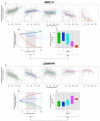Dissecting inflammatory complications in critically injured patients by within-patient gene expression changes: a longitudinal clinical genomics study
- PMID: 21931541
- PMCID: PMC3172280
- DOI: 10.1371/journal.pmed.1001093
Dissecting inflammatory complications in critically injured patients by within-patient gene expression changes: a longitudinal clinical genomics study
Abstract
Background: Trauma is the number one killer of individuals 1-44 y of age in the United States. The prognosis and treatment of inflammatory complications in critically injured patients continue to be challenging, with a history of failed clinical trials and poorly understood biology. New approaches are therefore needed to improve our ability to diagnose and treat this clinical condition.
Methods and findings: We conducted a large-scale study on 168 blunt-force trauma patients over 28 d, measuring ∼400 clinical variables and longitudinally profiling leukocyte gene expression with ∼800 microarrays. Marshall MOF (multiple organ failure) clinical score trajectories were first utilized to organize the patients into five categories of increasingly poor outcomes. We then developed an analysis framework modeling early within-patient expression changes to produce a robust characterization of the genomic response to trauma. A quarter of the genome shows early expression changes associated with longer-term post-injury complications, captured by at least five dynamic co-expression modules of functionally related genes. In particular, early down-regulation of MHC-class II genes and up-regulation of p38 MAPK signaling pathway were found to strongly associate with longer-term post-injury complications, providing discrimination among patient outcomes from expression changes during the 40-80 h window post-injury.
Conclusions: The genomic characterization provided here substantially expands the scope by which the molecular response to trauma may be characterized and understood. These results may be instrumental in furthering our understanding of the disease process and identifying potential targets for therapeutic intervention. Additionally, the quantitative approach we have introduced is potentially applicable to future genomics studies of rapidly progressing clinical conditions.
Trial registration: ClinicalTrials.gov NCT00257231
Conflict of interest statement
The authors have declared that no competing interests exist.
Figures






References
-
- Sasser SM, Hunt RC, Sullivent EE, Wald MM, Mitchko J, et al. Guidelines for field triage of injured patients. Recommendations of the National Expert Panel on Field Triage. MMWR Recomm Rep. 2009;58:1–35. - PubMed
-
- Soni A. The five most costly conditions, 1996 and 2006: Estimates for the U.S. civilian noninstitutionalized population. Statistical Brief. Rockville: Agency for Healthcare Research and Quality; 2009. pp. 1–5.
-
- Peden M, McGee K, Krug E, editors. Geneva: World Health Organization; 2002. Injury: A leading cause of the global burden of disease, 2000.
-
- DeCamp MM, Demling RH. Posttraumatic multisystem organ failure. J Am Med Assoc. 1988;260:530–534. - PubMed
Publication types
MeSH terms
Associated data
Grants and funding
LinkOut - more resources
Full Text Sources
Other Literature Sources
Medical
Research Materials

